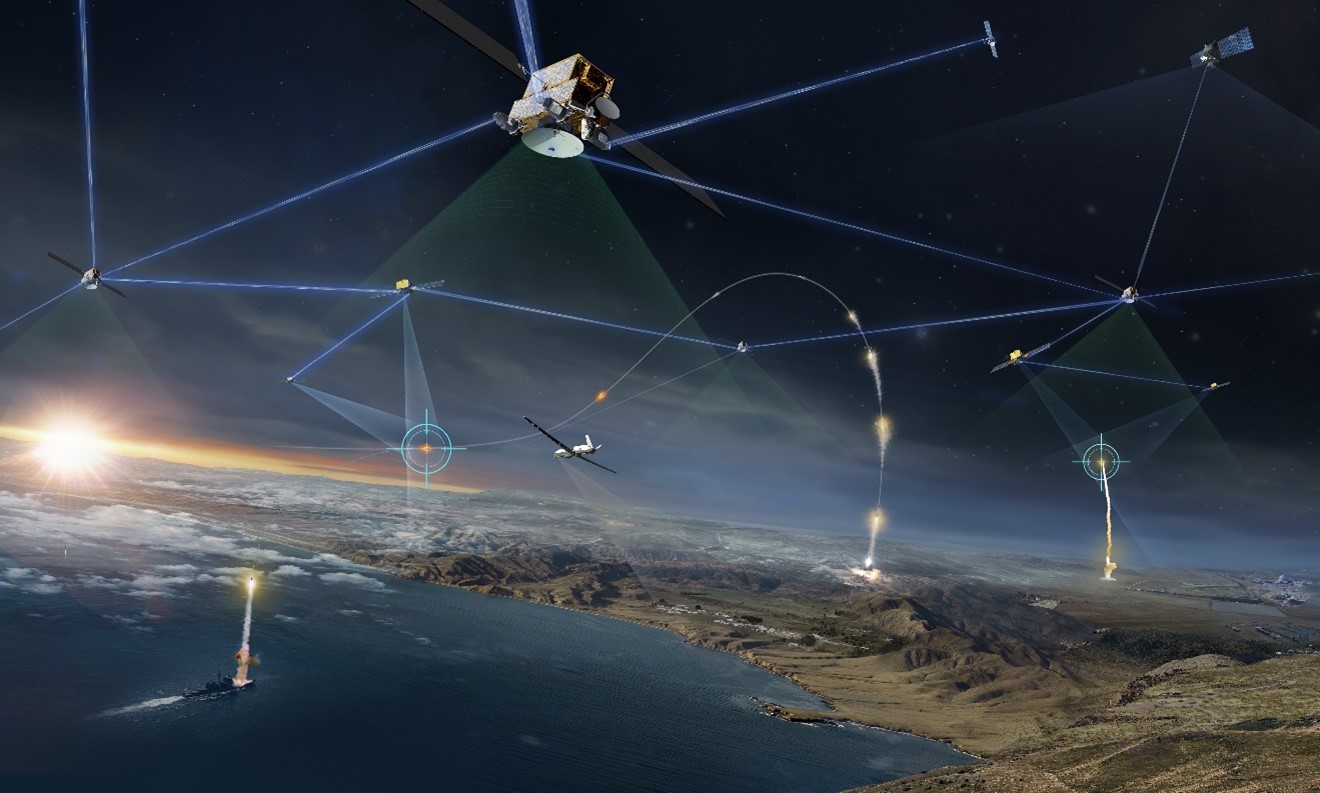
Northrop Grumman’s participation in SDA’s Tranche 1 Transport Layer program went from award to passing Critical Design Review in 13 months. Image courtesy of Northrop Grumman.
In August, the Space Force’s Space Development Agency (SDA) announced Northrop Grumman would design and build 36 data transport satellites, the first iteration in SDA’s newest generation of its Transport Layer.
The satellites – part of the Tranche 2 Transport Layer Beta (T2B) award – follow last year’s announced awards of 42 satellites under Tranche 1 Transport Layer (T1TL) and 14 satellites under the Tranche 1 Tracking Layer (T1 Tracking), which will provide missile warning and tracking for advanced missile threats.
The satellites in T1 Tracking will feature a wide field-of-view infrared sensor, optical communications terminals, and a Ka-band payload for communications and will interconnect with the Transport Layer satellites. Northrop Grumman is also providing the ground component for each element.
In this Q&A, we discuss the programs with Blake Bullock, vice president, Communications Systems at Northrop Grumman, and David Cadmus, director of the Mission Control Systems at Northrop Grumman.
Breaking Defense: As part of your T1TL demonstration, your team validated compatibility between commercially developed laser communications and US government encryption hardware. You’ve described this as a significant risk reduction and exciting step forward. How so?
Bullock: In space, risk is always a part of our job because it’s challenging to fix satellites once on orbit — though that’s something we’re working on making easier. But making sure we understand everything that could go wrong and mitigating those things before we launch is hardwired into the way we do things. Laser comm is no different.
Laser or optical communication is an exciting technology that’s been in the works on both commercial and government sides for many years. We’re getting to an inflection point where we’re seeing satellites that would normally be talking to each through radio frequencies, or RF, now able to talk in the optical frequencies, or lasers.
We’ve shown in a lab environment that we can get different, complex systems to talk to each other — to interoperate. It’s a big deal and represents a significant step in optical communications risk reduction. Proving that we know how to connect these dots successfully, that’s a big achievement.
Northrop Grumman illustration of its missile tracking satellites for the Space Development Agency’s Tracking Layer.
Breaking Defense: The first T1TL satellites are expected to be launched just three years from the program start, which is an ambitious schedule even for satellites without comms links. Describe your ability to quickly build proliferated systems at high-production rates.
Bullock: Northrop Grumman is well known for building high-performance satellites. As mission needs and environments change, there’s a lot of interest in having a proliferation of smaller satellites.
So, we’ve taken our experience with rapid prototyping and proliferated constellations, identified key industry partners, and then we’ve approached the program with our deep understanding of our customer’s mission and priorities. That’s a big part of how we’re moving quickly and at scale on these contracts.
For T1TL, T2B and T1 Tracking, it’s an opportunity to realize the vision of the Space Development Agency by partnering with the best of industry. And it’s in a different way than others may have seen us do before. To deliver at the speed the security environment demands, we’re pairing our experience and know-how with mature, commercially developed technologies from new entrants and smaller companies.
Airbus, for example, is our bus provider on T1TL. They give us a mature product and highly modern spacecraft production factory that enables us to hit SDA’s aggressive timeline and cost requirements.
Cadmus: To amplify, Northrop Grumman’s focus is on understanding the holistic architecture of the entire system, understanding our part in it, and driving that down into our partners so they can be interoperable and deliver value to our customers. In this case, it’s speed and capability.
Breaking Defense: You mentioned Airbus and you’re working with other companies such as the laser communication company Mynaric and non-traditional defense contractors on both T1TL and T1 Tracking. Tell us what companies like those have to offer.
Bullock: We see tremendous value in pulling together tried-and-true commercial products and integrating a solution to meet the exact needs of the mission. Our system and mission engineering are the glue that brings it all together. By expanding our toolbox and partnering across industry, we’re able to get the best of all worlds.
Mynaric is a great example of a partner that we’re excited to team with. Even though we have a tremendous amount of in-house expertise in different elements of laser comms, including complex elements like modems and telescopes, when we looked at the Tranche 1 mission, it made sense to go with a low-cost terminal designed for mass production, and they fit the bill perfectly.
Cadmus: It’s about understanding and managing the risk. Just because you can do something, doesn’t mean you should. And if you do it, you need to carefully plan out how and when.
We do that by testing on the ground and, most importantly, working through the CONOP. What is the new capability bringing? How will it change how it’s deployed to the user communities that rely on it? We ensure that it’s rolled out in a manner that everyone is ready to receive and won’t be disruptive to operations.
Breaking Defense: Bring us up to date on how you’re using rapid prototyping and digital engineering for programs like Protected Tactical Satcom (PTS).
Bullock: Protected Tactical SATCOM is the perfect example of how we are moving fast. We designed a satellite that we can launch in 2025 by selecting the right mix of demo-ready satellite components — like our ESPA-Star bus – and pulling from decades of advancements in next-generation secured SATCOM programs. We understand how to quickly tease out and address the hardest problems as early as possible and design a schedule that allows us to tackle these challenges in parallel. That helps us buy down risk ahead of what will be a fully deployed capability to support our warfighters.
Cadmus: Rapid prototyping starts in the design phase, and we utilize model-based systems engineering, which is part of our digital transformation initiative, to model out all aspects of the system. We pull our customers directly into that model to show them how it’s going to work, how it’s going to interoperate with the users, and to get early insights to further burn down risk before we fly it.
Breaking Defense: Final thoughts?
Bullock: Northrop Grumman is innovating and moving with speed above and beyond what people have come to expect from large space primes. We announced in April that our Tranche 1 Transport Layer program went from award to passing our critical design review (CDR) milestone in just 13 months. That’s incredibly fast, most programs take years to pass CDR. We’re meeting our customers where they’re going to be, and we are thinking end-to-end about this resilient, hybrid and interoperable architecture.
As I said earlier, we’re at an inflection point where we’re taking the lead in changing what mission capability is for our customers.
We’re thrilled to have the opportunity to work with commercial and non-traditional partners. With our SDA T1 contracts, we’re proving that we can do that. We’re showing we can do things differently, and I think people are excited to see what we are accomplishing.
Cadmus: Northrop Grumman is known for exquisite systems and that same drive is used to solve hard problems in cost and speed of production. As we said earlier, that comes from bringing a holistic view of the mission, an understanding of our customer’s problem sets, and knowledge about how to break down the challenge into architectural components and interfaces that enables the best of industry to bring their capabilities to solve our customer’s problems.





















